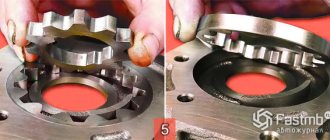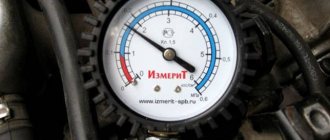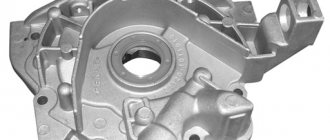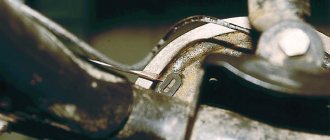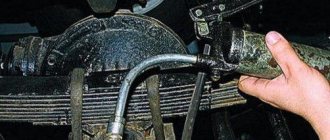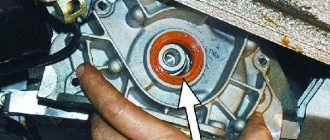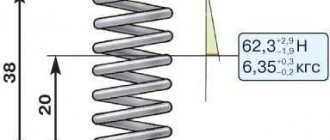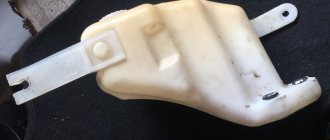Replacing the engine oil pump with your own hands Instructions + Video
The oil pump is the main part of the engine system, affecting the circulation of lubricant throughout all mechanisms. It is he who creates the necessary pressure, working from the crankshaft. Over time, the device wears out, forcing the owner to replace it. Find out how to do it yourself.
Malfunctions of the pump and the system as a whole
As you know, nothing lasts forever in this world and everything has to be repaired over time. The oil system of the Shtil ms 180 is no exception, and has its own specific malfunctions. Let's take a closer look at them.
Signs of a malfunctioning lubrication system are as follows:
- the chainsaw chain is absolutely dry and does not shine;
- oil does not leave the oil tank;
- the chain stretches quickly and this happens constantly;
- the saw bar moves to the side when sawing;
- The tire also heats up in the area of the drive sprocket and the paint melts.
All these signs directly or indirectly indicate problems in the chainsaw chain lubrication system.
The first thing to do after you suspect that chain lubricating oil is not being supplied is to check its supply. There are two ways to do this. The first is described in detail in the instructions for the tool and consists in the fact that you need to start the chainsaw, increase the gas as much as possible and point it towards any obstacle.
If the lubrication system is working properly, the oil will fly off from the tip of the tire and a strip of oily drops will appear on the surface towards which the tire is pointed. If there are still violations in the system, the surface will remain clean.
The second way is to remove the tire from the chainsaw and start it. When the engine speed increases, oil will flow from the oil channel at the tire shank installation site; if this does not happen, it is necessary to look for the cause of the malfunction.
Diagnostics
Diagnostics should begin with inspecting and checking the oil receiver (filter) of the Stihl 180 saw. As a rule, if the filter is very dirty, the oil supply may stop.
Next, you need to remove the drum sprocket and check the condition of the drive gear. The thread on it must be clearly defined, not licked or have any other defects; also, when the gear is removed, it is necessary to check the wire lever. It must press the gear tightly and not turn, otherwise the gear stands still and does not transmit force to the pump, as a result of which the oil supply stops.
If all of the above methods to detect and eliminate faults do not produce results, it is necessary to use extreme measures, i.e. dismantle the pump.
How to remove the pump
The oil pump is installed on the right side of the bottom of the housing, in the same place an oil line coming from the chainsaw tank is connected to it. To remove the pump, you will first need to release the saw from the handle; to do this, unscrew the rear handle of the unit and disconnect the throttle control rod. At the next stage, you need to remove the handle shock absorber plugs and, using a powerful slotted screwdriver, squeeze them out of their seats on the handle.
After the handle is removed, the chainsaw body is turned upside down. The hose leading from the oil tank to the pump will be immediately visible. It must be removed from its seat.
To better understand the process of removing the pump, you can watch the video below. In the video, the service center master shows in detail how to remove the oil pump from a chainsaw, and also describes the main malfunctions of the supply system.
After the pump is removed, it must be cleaned and purged. As a rule, the main failure of the oil pump is its blockage. Having eliminated it, you can install the pump in place.
Replacing the pump is only required if it is not possible to remove the blockage.
Automatic transmission diagnostics
Repairing automatic transmissions just like that, at random, is impossible. For its high-quality organization, it will be necessary to diagnose the unit. Even if the automatic transmission fails again after repair, it would be irrational to blame the previously broken unit again, because there are more than a hundred elements in the design of the automatic transmission. Each of them may well break down at the most inopportune moment.
Determining what exactly has gone wrong in the box takes place in several inseparable stages:
The first stage is an analysis of the operation of the unit both “cold” and “hot”
If, when starting the car, the automatic transmission does not change gears or works incorrectly in some other way, and when warming up all the problems disappear, you should pay attention to the valve body and the level and quality of the oil poured into the box. This type of work often indicates problems in the lubrication system of the machine.
In a situation where noise in the automatic transmission or its jerking, kicking is repeated in all modes of engine operation and throughout the entire operating time of the unit, with a high degree of probability we can say that not only problems in the oil supply may be to blame; The second stage is checking the box through the control panel and on-board computer. Here, perhaps, everything is extremely simple. It's no secret that most modern cars are fully electronic, so breakdowns of certain components are diagnosed independently using special sensors. Automatic transmission maintenance is no exception, so the occurrence of transmission breakdowns is also displayed in electronic devices. Often information from this is very useful when organizing machine repairs; The third stage is complete or partial disassembly of the box. Unfortunately, this cannot be avoided, especially if the signs of an automatic transmission malfunction are quite severe and cannot be eliminated by simply changing the oil or flushing the transmission. If your particular machine has a removable tray, then first you should remove it and evaluate the visible components. Are there any problems? Then you will have to remove the box completely, disassemble it and, analyzing the signs of a malfunction of the automatic transmission, look for the broken element.
In general, there are no particular difficulties in answering the question of how to check an automatic transmission. Diagnostics of the box is carried out by organizing the steps noted above. Of course, some steps are not so easy to implement, but you cannot do without them, so you should be prepared for difficulties. If you are not ready to check the machine yourself, then it is better not to experiment and entrust this work to professionals. This approach will not only simplify the repair of the unit, but will also speed up its progress several times.
How to replace an oil pump yourself
Having determined that the oil pump needs replacement or repair, it is necessary to remove the mechanism from the engine.
Tools for work
In order to dismantle the unit, you will need a standard motorist kit, consisting of the following list:
- keys to “10” and “13”;
- socket heads;
- extension cord;
- cardan joints.
How to remove the oil pump
If the work is carried out on an injection engine rather than a carburetor engine, then the crankshaft position sensor will need to be removed from the engine. Otherwise, dismantling the mechanism is performed in the same sequence:
- We de-energize the vehicle's on-board network by removing the “—” wire from the battery.
- Loosen the generator fasteners and remove the belt.
One of the first procedures for dismantling the oil pump is to remove the alternator belt.
After draining the oil, dismantle the engine protection and sump
To remove the crankshaft pulley, you will need to remove the timing belt.
One of the steps to dismantle the oil pump is to remove the crankshaft pulley
The oil receiver is attached to the main bearing cap with two bolts and one bolt to the oil pump
The pump is secured with six bolts, unscrew them
Having unscrewed all the fasteners, move the pump away from the main bearing cap and remove it from the engine.
Video: dismantling the oil pump on a VAZ 2108/2109
Pump installation
To perform reassembly, follow these step-by-step instructions:
- Before installing the assembly, the drive gear is installed accordingly.
Before installing the oil pump in place, the drive gear must be set in a certain position
The drive gear must align with the flats on the crankshaft
Before installing the pump, coat the working edge of the oil seal with engine oil.
After lubricating the oil seal with engine oil and installing it in its seat, install the pump
Symptoms of a faulty oil pump
The main signs of problems in the lubrication system are sounds uncharacteristic of engine operation and the oil pressure light coming on. In this situation, you should stop, turn off the car and after a while check the oil level in the engine with a dipstick (you need to wait a little until the oil drains into the sump). If the level is below the minimum, add oil and check the level again (it should be between the min and max marks). If the light goes out when starting the engine, the reason it came on was precisely the low oil level.
A burning oil pressure light indicates a problem with the lubrication system.
If, after adding oil, the extraneous sounds do not disappear and the light continues to light, you should not continue driving. Most likely, there is a problem with the oil pump and will require replacement or repair. You can get to the garage or car service using a tow truck or tow. However, the light may also be on due to a failure of the oil pressure sensor. Therefore, until an accurate diagnosis is made, you should not rush to repair the oil pump and start disassembling the engine.
How to adjust the oil supply to a chainsaw chain?
Adjusting the oil supply level is necessary when operating the tool under difficult conditions. The supply level is controlled by a shaft with an eccentric mounted on it, which rests on the pump plunger.
Rotation of such a shaft displaces the plunger relative to the longitudinal axis. This allows you to increase or decrease the volume of the pump’s discharge chamber and quite accurately adjust the level of supply of the working fluid. To do this, at its lower end there is a groove with which adjustment is made.
As a rule, the screw is accessible from the bottom of the chainsaw. For example, in order to adjust the oil supply to the saw set of chainsaws of the Ural family, you must perform the following steps:
- At the bottom of the saw, next to the bar, find the adjusting screw. It is located next to the stamping, which shows the direction of its rotation;
- Use a screwdriver to turn the shaft in the direction of increasing or decreasing the oil supply level.
When performing these actions, remember that the shaft is designed to rotate up to 90⁰. Exerting too much force will lead to breakage of the screw retainers and possible interruption of oil supply to the friction surfaces.
Video instructions can be viewed by following the link
Oil pumps for internal combustion engines of cars
Since different cars are equipped with different types of engines with different operating parameters, the design of oil pumps can also be different. All modifications of these devices are divided into adjustable and unregulated.
With adjustable models, it is possible to change the performance in order to achieve optimal system pressure under different conditions. In the case of unregulated devices, the parameters are adjusted using special pressure reducing valves.
In car engines, gear and rotary type oil pumps are most often installed. In this case, the movement of oil through the system and the creation of pressure is carried out thanks to rotor blades.
In gear type pumps, these same functions are performed due to the movement of gears. They can be made in two modifications - with an external type of gearing or with an internal one. An external gear pump has two gears located next to each other, while an internal gear pump has one inside the other. With the same performance, the overall dimensions of gear pumps differ according to the type of gearing.
A few words about the service life of the automatic machine of modern passenger cars
Automatic transmissions released in recent years have become noticeably more reliable than their predecessors. Despite this, the complexity of the design of such a transmission requires its owners to properly operate and maintain it. Often, violations in the organization of these particular events provoke typical unit breakdowns, in which the automatic transmission hums or begins to “kick” or “push.”
To prevent a kicking transmission from causing inconvenience to the owner, first of all, he must study in detail the rules of operation and maintenance of the machine. With the proper approach in these procedures, automatic transmission malfunctions will bypass any motorist, and its unit will cover its entire operational mileage without any problems. By the way, the service life of many automatic transmissions of modern cars is designed for the service life of the engines with which they are equipped. That is, the service life of an average automatic machine is 300,000-600,000 kilometers. Quite a lot, right?
Why us?
Tiptronic car service is an experienced team of craftsmen with all the necessary equipment and tools. Reviews from satisfied customers and an impeccable reputation in the automotive service market speak for us. We will repair the automatic transmission pump or install a new one. Our specialists will cope with tasks of any level of complexity. Our advantages include free diagnostics when ordering repair work, the best price in the capital, a large selection of consumables and spare parts, and an individual approach to customer needs.
Contact us to agree on all the details of cooperation.
Location
The oil pump in an automatic transmission is located inside the gearbox, so if problems arise with this element, it is necessary to dismantle the protective metal casing from the automatic transmission. In most cases, repair work does not require removing the transmission from the vehicle. However, in this case, you must take into account the design features of each specific vehicle and specific modifications of the automatic transmission. Only an experienced technician will be able to quickly determine the location of the oil pump and carry out all the necessary repair work as quickly as possible.
In order to understand the location of the oil pump, familiarize yourself with the automatic transmission structure as a whole.
The design and principle of operation of the oil pump - Video
Do-it-yourself KAMAZ oil pump replacement
The entire process of replacing the oil pump on a KAMAZ vehicle can be divided into three stages:
- Preparatory.
- Removing the old pump.
- Installing a new one.
Each stage consists of several actions that must be performed in strict sequence.
It is important to prepare the work area, tools and a new oil pump in advance
Tools for work
To quickly and easily remove and install a new oil pump, you will need:
- standard set of open-end wrenches;
- special puller for gears;
- screwdriver with a flat thin blade;
- screwdriver with a Phillips blade.
Usually in the garage every driver of a car or truck has such a suitcase with a set of all the necessary tools for self-repairing the car
And you also need to stock up on rags and a container for draining the oil in advance.
Preparatory stage
After all the necessary tools have been collected, you will need to perform a number of actions on which the safety and convenience of the operation depends:
- Drive the KAMAZ into the pit.
- Remove the wire from the negative terminal on the battery.
- Make sure the car is completely cool.
- Drain the oil from the crankcase (pull out the plug and place a basin under the drain).
- Unscrew the bolts securing the engine crankcase - only by removing the protection itself will you be able to get to the pump.
- Remove the crankcase and set it aside.
- It is recommended to immediately clean the protective housing from dirt.
The inspection hole is needed for general convenience of work, since you will have to crawl under the car when replacing the pump
The procedure for removing the pump from KAMAZ
The first thing the driver will see after removing the crankcase is access to the pump suction tube.
Together with it, a flange, mounting bracket and cup are connected to the pump. However, it will not be possible to dismantle the pump with bare hands:
- Take a special gear puller.
- Use it to remove the oil pump gear: first screw the gear all the way in so that the main screw rests against the end of the shaft. Then start rotating the puller handle to unscrew the gear.
- Next, remove the bolts securing the radiator and discharge sections. These are the top and bottom parts of the pump.
- Disconnect all lines from the oil pump. There may be slight oil leakage from under the hoses, so it is best to immediately block the holes in them with a rag.
- Unscrew the three pump fixing bolts.
- Remove the pump.
- Remove gasket residues from the landing site.
Video: dismantling procedure
New pump installation process
Before installing a new oil pump, drivers usually thoroughly clean the mounting area of dirt.
And it doesn’t hurt to wipe the hose joints with a clean cloth, since it is at the joints of the hose and fitting that the largest amount of dust mixed with oil usually accumulates.
Due to dirt, problems may arise in the near future, since the fluid in the lubrication system must always be clean.
Video: oil pump installation procedure
Therefore, after cleaning the seat on the bottom plane of the cylinder block, you can proceed with a “light heart” to install a new oil pump:
- Pour a small amount of the oil used into the pump housing.
- Rotate the gear so that the lubricant can immediately penetrate to all parts of the pump - this way the device will start working faster.
- Install the adjusting shim in place.
- Next, install the valve mechanism tube gasket.
- Install the pump onto the cylinder block with three bolts, but do not tighten it yet.
- Install the valve tube with two bolts.
- Attach the suction pipe bracket to the cylinder block with one bolt.
- After this, it is allowed to tighten all bolted connections until they stop.
- Be sure to check the gear clearance. Ideally, the gap should be between 0.15 and 0.35 mm. If it is not there, you will have to unscrew the pump and place another gasket under it.
- Connect all fuel lines to the pump.
- Pour oil into the engine.
- Screw the crankcase into place.
- Connect the wire to the negative terminal of the battery.
troubleshooting
Don't rush to conclusions and blame the pump for everything. It is necessary to organize a full check to make sure what caused the signal to appear on the dashboard.
Check area
Your actions
You need to check the functionality of the electrical circuit that goes from the sensor to the instrument panel. The wire that goes from the regulator to the engine must be connected to ground. If the circuit is working properly, the lamp will go out.
Checking the oil filter
Just unscrew the oil pressure sensor. If it is soaked in lubricant, everything is fine. If it is dry, then the filter is clogged or the filter valve is stuck.
Checking internal elements
You will need to replace the filter if there is a problem with it. Next, the pan is opened and the condition of the oil receiver and rubber seals are inspected.
If the measures taken did not produce results, the lamp still does not go out, then the pump is the culprit in the current situation.
Useful information
Let's talk a little about the principles of the design and operation of the oil pump. This can help you during the repair process.
- Domestic “tens” use a combined lubrication system.
- The design of the car provides for the presence of a gear oil pump. It is installed on the front end of the cylinder block.
- Special gears with trochoidal internal gearing help reduce mechanical losses during rotation.
- The pump is equipped with a full-flow filter with a non-separable design. It contains an anti-drip and bypass valve.
- This design guarantees efficient circulation of lubricant throughout all engine components.
- The pump operates by rotating the crankshaft. The connection is direct.
- The operating life of the pump is about 120 thousand kilometers.
Location
Not everyone knows where to look for this oil filter. It is not located in a visible place, so you will have to try hard to gain access to the device.
The MN is located directly inside the engine oil sump. To get to it, the oil must be drained from the engine.
Please note that if your engine uses high-quality oil that was only recently filled, use a clean container when draining it so that you can then refill the same substance. If the oil is old, replacing the pump is an excellent reason to change the lubricant.
Engine oil pump repair
The pump, removed from the engine being repaired, is subjected to in-place diagnostics after cleaning. In the absence of external defects, the technical condition of the pumps is assessed by the end gap between the housing and the discharge gears and by the gap in the bearings of the drive roller. An increase in the end clearance leads to a decrease in pump performance. The end gap is determined by an indicator device based on the amount of axial movement of the pump drive shaft. For SMD-60, A-41, A-01M engines, the permissible gap without repair is 0.30 mm, and for other diesel engines - 0.25 mm. The bearing clearance is assessed by the radial movement of the drive roller neck.
If the gaps are within acceptable values, then the pump is tested on a stand and its volumetric flow is determined for diesel engines, and for carburetor engines, the supply pressure when pumped through a nozzle of a certain cross-section. In case of unacceptably large movements of the roller, the pump is disassembled and repaired.
Step-by-step instructions for repairing and inspecting oil pump parts:
1. For a detailed inspection, it is necessary to remove the oil pump.
2. First, you need to unscrew the bolt (1) and remove the crankshaft position sensor (2), which is only available on engines with a fuel injection mechanism.
3. When disassembling the pump, you need to unscrew the six bolts and remove the pump cover.
4. Using two screwdrivers, you need to lift the pump housing so that the pins on the housing can come out of the holes located in the cover of the VAZ 2110 oil pump. Now remove the housing itself by disconnecting it from the cover.
5. We take the gears out of the cover: first the driving one, and then the driven one.
6. Now you need to unscrew the pressure reducing valve plug. An O-ring must be installed under this plug. Inspect the ring - if it is too compressed, it needs to be replaced.
7. Having unscrewed the plug, we take out the spring of the pressure reducing valve.
8. Now we take out the valve itself, gently tapping the body on a clean wooden stand. If the valve does not come out, it must be removed using a thin pointed object, preferably also wooden, so as not to damage the surface.
9. Now you need to carefully inspect the aluminum cover for visible signs of wear, mechanical damage, deep scratches in the contact areas of the gears. If found, the cover must be replaced with a new one.
10. Next, repairing the oil pump involves inspecting its housing. In the same way, visible signs of wear are not allowed on working surfaces - mechanical damage, scuffing. If we find any of the above, we replace the housing.11. The maximum permissible diameter of the driven gear socket is 75.1 mm, so we measure the diameter, and if it exceeds the permissible value, we will also have to replace the housing.
12. Now you need to measure the width of the body segment in the middle part. If the measured value is less than 3.4 mm, the VAZ 2110 pump housing must be replaced.
13. Check the gears. The thickness of the drive should not be less than 7.42 mm. We measure: if it is less, we replace the gear.
14. The same applies to the slave. If the thickness is less than 7.35 mm, the gear must be replaced.
15. Then we check the axial clearances of the gears. It is necessary to install the drive gear back into the housing, after which we apply a steel ruler to the housing and use a feeler gauge to measure the gap between the gear and the ruler.
16. In the same way, measure the axial clearance between the attached ruler and the driven gear. For the drive and driven gears, the maximum permissible axial clearance is 0.12 mm and 0.15 mm, respectively. In cases where these values are exceeded, the gears must be replaced with new ones.
17. Through calculation, more accurate values of axial clearances can be obtained. To do this, a micrometer is used to measure the thickness of the oil pump housing along the outer surfaces, as well as the thickness in the area of the sockets for the drive and driven gears along milled surfaces in several places. The axial clearance is calculated based on the difference between the arithmetic mean of the socket depth and the measured thickness of the gears.
18. The next stage of repair is to inspect the pressure reducing valve seat to detect rough scratches and other deep mechanical damage on the inner surface. If found, the cover must be replaced.
19. If burrs and deep mechanical scratches are detected on the pressure reducing valve itself, it must also be replaced with a new one.
20. We also replace a bent, broken/broken or cracked pressure relief valve spring. The height of the spring in its free state is normally 44.72 mm; the same parameter under a load of 4±0.24 kgf is 31.7 mm. If there is a discrepancy, the spring must be replaced.
21. Assembling the oil pump. We install the driven gear with the chamfers on the teeth towards the housing.
22. Then install the drive gear in the same way - with the chamfers on the teeth facing the body. The gears must be lubricated with engine oil before installation.
23. Now you need to install the cover on the body and tighten the fastening bolts.
24. Before installing the pressure reducing valve into the seat with the bottom down, it must be lubricated with engine oil. Then you need to install the spring and tighten the plug with the aluminum O-ring of the oil receiver tube, also pre-lubricated.
25. It is necessary to pour engine oil into the pump through the oil receiver tube.
26. At the end of the repair and complete assembly of the car’s oil pump, turn the gears several turns so that the working surfaces of the gears are well lubricated.
Video
VAZ
Causes of oil pump failure
The first and most common cause of oil pump failure is a clogged oil receiver, as a result of a clogged crankcase. In case of malfunctions of this kind, it is recommended to drain the oil, dismantle the pan, and then wash it together with the oil receiver. Since the oil filter is located after the pump, unfiltered lubricant passes through the oil receiver and some other parts, which increases the likelihood of oil contamination and wear on parts.
Another common failure of the oil pump is damage or breakage of the unit body or its gears. The result of such damage is an increase in the gap between these parts. Theoretically, it is possible to replace the oil pump housing or make weld deposits with further adjustment, but this process is expensive and quite labor-intensive. Therefore, often at the first symptoms of an oil pump malfunction, worn parts are immediately replaced.
Causes of oil pump failure:
1. The oil level in the crankcase is constantly low. 2. Breakdown of devices that are responsible for controlling pressure. 3. Use of low-quality oil with inappropriate viscosity. 4. Oil and coolant are mixed. 5. Oil pump intake is dirty. 6. Contamination of oil filter components. 7. Failure of safety or lubrication valves.
How to determine if an oil pump is faulty
There are two types of pump testing - without dismantling it and with dismantling it. Without removing the pump, you can verify its malfunction only when it is already in a “dying” state, so it is better to remove it to perform detailed diagnostics.
How to check the oil pump without removing it
Before directly testing the pump, it makes sense to check the oil pressure in the system using a pressure gauge. This way you can make sure that the oil pressure light is working correctly and did not light up in vain. To do this, a pressure gauge is screwed in instead of the emergency lamp pressure sensor.
Please note that the pressure value often drops precisely “when it’s hot,” that is, when the engine is warm. Therefore, the test must be carried out on a warm engine and at idle speed.
The minimum and maximum pressure values will differ for different machines. For example, for a VAZ “classic” (VAZ 2101-2107) the minimum emergency pressure value is 0.35...0.45 kgf/cm². It is under such conditions that the emergency lamp on the instrument panel is activated. The normal pressure value is 3.5…4.5 kgf/cm² at a rotation speed of 5600 rpm.
Signs that suggest repairs
Problems with the oil pump in the transmission lead to insufficient lubrication of the moving parts and an increase in the overall temperature inside the transmission. As a result, significant problems with moving mechanical parts can occur, resulting in the need for costly and complex repairs. That is why at the first sign of oil pump failure, we recommend that you contact experienced specialists. The car owner can identify problems with the gearbox by the appearance of noticeable jerks in the automatic transmission when shifting some gears, which may indicate insufficient lubrication of the clutches, acceleration dynamics suffer, and a continuous howl appears, which changes depending on engine speed. Diagnosis of automatic transmission faults | How to check the automatic transmission oil pump as well. We recommend that you contact the service center as soon as possible, which will allow you to fix the breakdown at minimal cost. Repair of the automatic transmission pump should be carried out by experienced specialists.
To replace the automatic transmission pump, you must first remove the box
Causes of oil pump failure
The reason why the oil pump has failed can be determined by diagnostics. There are at least 8 main oil pump faults. These include:
- Clogged oil pickup strainer. It is located at the inlet of the pump, and its function is to coarsely filter the engine oil. Like the system’s oil filter, it gradually becomes clogged with small debris and slag (often such slag is formed as a result of flushing the engine with various means).
- Malfunction of the oil pump pressure reducing valve. Usually the piston and spring included in its design fail.
- Wear of the inner surface of the pump housing, the so-called “mirror”. Occurs for natural reasons during engine operation.
- Wear of the working surfaces (blades, splines, axles) of the oil pump gears. It happens both over time of long operation and due to rare changes of (very thick) oil.
- Using dirty or unsuitable engine oil. The presence of debris in the oil can be for various reasons - careless installation of a pump or filter, use of low-quality lubricating fluid.
- Careless pump assembly. In particular, various debris was allowed to get into the oil or the pump was not assembled correctly.
- Drop in oil level in the engine crankcase. Under such conditions, the pump operates at excessive capacity, which causes it to overheat and may fail prematurely.
- Dirty oil filter. When the filter is very clogged, the pump has to make significant efforts to pump the oil. This leads to its wear and partial or complete failure.
Regardless of the reason that caused the partial failure of the oil pump, it is necessary to carry out a detailed check of it and, if necessary, make repairs or complete replacement.
Types of plunger pumps
Plunger pumps installed on modern chainsaws are:
- Adjustable;
- Unregulated.
Unregulated pumps are usually installed on household-grade tools, for example Yamamoto CS-4552, Husqvarna 135 Mark II, Kruger GCSK 35-45, Husqvarna 120 Mark II. Such units provide a stable supply of working fluid regardless of operating conditions. They have a simple but reliable design. Their disadvantages include the lack of adjustment of the supply of lubricant to the friction surfaces.
Adjustable pumps are installed on chainsaws of semi-professional and professional classes, such as powerful chainsaws from Energomash, American McCulloch, Procraft, Parma. They have a more complex design.
The adjustment function is necessary when the saw is operating under difficult operating conditions, when the amount of working fluid specified by the manufacturer is not enough to properly lubricate the saw set. In addition, it may be needed when the plunger is slightly worn, when the pump cannot provide enough oil to lubricate the bar and chain.
The photo shows 3 types of adjustable oil pumps
How to Change the Oil Pump on a VAZ 2106
Replacing the oil pump on a VAZ 2101-VAZ 2107
Welcome! Oil pump. Usually called the "oil pump", it performs a very important function when the engine is running, namely, it supplies oil located in the oil pan, the crankshaft bearings and then through the air duct, distribution oil and the camshaft bearings, in most cases lubricating them.
Therefore, the oil pump plays a very large and important role in a car engine, and if it is damaged, then the lubrication system should not have the pressure it should have. (For more information about what will happen if the pressure in the lubrication system disappears, see the article “Useful information about oil pressure on a VAZ”).
The note! To replace the oil pump with a new one, you will need to stock up on: a basic set of wrenches, which will include a "10" and "13" wrench, and you will need to take the end sockets and extension cord to match the same heads, if possible, and pack your pockets with you!
Where is the oil pump located? It is located inside the engine so just by looking at the engine you won't see it, but to look at it you will first need to remove the crankcase, then you will need to remove the pan and only then will you see the oil pump with your own eyes.
READ Renault Logan Heater Fan Doesn't Work
When should I replace my oil pump? It can be replaced with:
1. Pressure drop in the vehicle's lubrication system at engine idle temperature, as shown by the oil pressure indicator.
2. As well as failure of the pump itself or its transmission, which, by the way, can be replaced individually without completely replacing the oil pump, see Article: “Oil pump repair.”
The note!
Sorry for the quality of lighting, this video shows the method of replacing the oil pump of you 2106
No.
Diagnostics and replacement of VAZ classic oil pump (LADA 2101-07)
Oil pump
the main part of any engine. And how much the engine depends on its condition. If you notice a drop in oil pressure after a hard blow to a bump that causes the crankcase to deform, it is likely that the oil pump, namely its intake pipe, is to blame for the drop in oil pressure! 3. And if your car's oil pressure is too high and outside the normal range, then most likely the culprit is a clogged relief valve, which can also be removed and replaced with a new one. (See How to remove this in the same pump repair article)
READ What is the fuel consumption of the Nissan Almera?
The note! What pressure in the lubrication system can you determine using a special indicator that shows the oil pressure in the system!
Required tools + consumables
Here are the tools and equipment you will need:
- containers for draining used car fluid and antifreeze;
- set of wrenches and sockets;
- jack, winch;
- cardan, ratchet, extension;
- compressor or can of compressed air;
- wooden hammer;
- fine abrasive paper;
- special lapping paste and lubricant for bolts;
- fresh oil, antifreeze;
- new oil pump, filter, gaskets.
